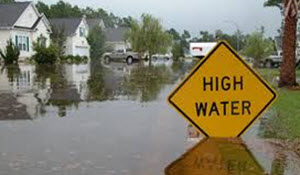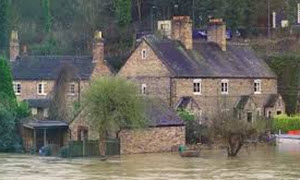A standard home owners insurances is sometimes not enough to protect you against the financial costs of flooding. Flooding can be expressly written out of the standard insurance policy, or simply seen as force majeure or Act of God and therefore not covered. There are also jurisdictions where getting standard home insurance even though you live in a flood risk area will nullified or decrease your right to get money from the insurance company in the event of flooding.
Flood insurance in the United Kingdom
Over 5.5 million homes in the United Kingdom are considered at risk of flooding. The UK Environment Agency are keeping updated flood maps for those who want to know more. There are four categories of risk: very low, low, medium and high. A high-designation means that there is at least a 1 in 30 chance of flooding in any given year. An area is considered very low risk if the chance of flooding in any given year is estimated at less than 1 in 1,000.
 To be adequately covered against flooding you need both buildings flood insurance and contents flood insurance. In many cases, getting both of these polices from the same insurance company will not only give you a lower premium but will also make the bureaucracy easier for you after a flood since you wont be dealing with two different insurance companies.
To be adequately covered against flooding you need both buildings flood insurance and contents flood insurance. In many cases, getting both of these polices from the same insurance company will not only give you a lower premium but will also make the bureaucracy easier for you after a flood since you wont be dealing with two different insurance companies.
Within the UK, insurers and the government have been working together to devise schemes that will make it possible for households to insure even high-risk buildings at a reasonable cost. Flooding insurance is not just important to help the homeowners after a flood – it can also be necessary to obtain flood insurance to be approved of any mortgage.
At the time of writing, the flooding element of UK household insurance premiums is capped at £210 a year for homes in council tax bands A and B, and at £450 a year for homes in band G. There is currently no cap for homes in tax band H, nor for homes built after 2009. These numbers can change, so always check up the latest rules and regulations before you go shopping for flood insurance in the UK.
Getting the premium down for flood insurance
 Sometimes it is possible to negotiate a better deal with your insurance company (e.g. lower premium or increased coverage) if you do certain things to make your home more flood resilient. You can for instance install flood-proof doors and windows, replace sensitive floorboards with a more durable concrete floor, and make sure that all electrical sockets, wiring, fuse boxes, etc are located at least 1.5 meters above floor level. One aspect of flooding that many homeowners do not think about in advance is that even if the flood never reaches your house directly, your home can still be damaged by wastewater that flows back into the property through the sewage system due to flooding further down the line. Non-return valves installed on water inlets, water outlets and all drains can decrease the risk of such an unpleasant experience.
Sometimes it is possible to negotiate a better deal with your insurance company (e.g. lower premium or increased coverage) if you do certain things to make your home more flood resilient. You can for instance install flood-proof doors and windows, replace sensitive floorboards with a more durable concrete floor, and make sure that all electrical sockets, wiring, fuse boxes, etc are located at least 1.5 meters above floor level. One aspect of flooding that many homeowners do not think about in advance is that even if the flood never reaches your house directly, your home can still be damaged by wastewater that flows back into the property through the sewage system due to flooding further down the line. Non-return valves installed on water inlets, water outlets and all drains can decrease the risk of such an unpleasant experience.
Always check with insurance providers before flood-proofing your home, to make sure you comply with their requirement and also get the most bang for your buck. Most of us are on a limited budget when it comes to home improvements, so it is important to prioritize wisely.